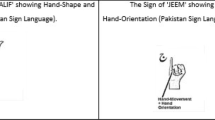Abstract
The purpose of this paper is to investigate the feasibility of offering a multilingual platform for text-to-sign translation, i.e., a solution where a machine translates digital contents in several spoken languages to several sign languages in scenarios such as Digital TV, Web and Cinema. This solution called OpenSigns, is an open platform that has several common components for generic functionalities, initially originated from the Suíte VLibras, including the creation and manipulation of 3D animation models, and interchangeable mechanisms specific for each sign language, such as a text-to-gloss machine translation engine, a sign dictionary for each sign language, among others. Our motivation is that the concentration of efforts and resources around a single solution could provide some state-of-the-art improvement, such as a standard solution for the industry and a greater functional flexibility for common components. In addition, we could also share techniques and heuristics between the translation mechanisms, reducing the effort to make a new sign language available on the platform, which may further enhance digital inclusion and accessibility, especially for poorest countries.
Access this chapter
Tax calculation will be finalised at checkout
Purchases are for personal use only
Similar content being viewed by others
Notes
- 1.
The Suíte VLIBRAS is the result of a partnership between – removed for blind review, and consists of a set of tools (text, audio and video) for the Brazilian Sign Language (LIBRAS), making TVs, computers, mobile devices and Web platforms accessible to deaf. Currently, VLibras is used in several governmental and private sites, among them the main sites of the Brazilian government (brasil.gov.br), Chamber of Deputies (camara.leg.br) and the Federal Senate (senado.leg.br). Further information can be obtained from http://www.vlibras.gov.br.
- 2.
This API is able to identify the input language of a sentence and translate it automatically into a target spoken language (www.google.com/translate).
- 3.
- 4.
In this test, the authors randomly selected 69 sentences and two LS interpreters generated a sequence of glosses in LIBRAS for each one. Then the VLibras translator was used to automatically generate a sequence of glosses of these same sentences and the values of the WER and BLEU metrics were calculated for the two scenarios.
- 5.
- 6.
References
Deaf sign language on world. https://www.ethnologue.com/subgroups/deaf-signlanguage. Accessed 30 Nov 2016
Fundación hetah - herramientas tecnológicas para ayuda humanitaria. http://hetah.net. Accessed 29 Nov 2016
Hand Talkc. http://www.handtalk.me/. Accessed 25 June 2015
Learn Sign Language in a Playful Way with SiGame – The App. http://theartofservice.com/learn-sign-language-in-a-playful-way-with-sigamethe-app.html. Accessed 30 Nov 2016
ProDeaf. http://prodeaf.net/OQueE/. Accessed 25 June 2015
Rybená Web. http://www.rybena.com.br/site-rybena/conheca-o-rybena/web. Accessed 25 June 2015
Araújo, T.M.U.: Uma solução para geração automática de trilhas em língua brasileira de sinais em conteúdos multimídia (2012)
Araújo, T.M.U., Ferreira, F.L.S., et al.: An approach to generate and embed sign language video tracks into multimedia contents. Inf. Sci. 281, 762–780 (2014)
IBGE: Population census 2010: General characteristics of the population, religion and people with disabilities. Technical report, Brazilian Institute of Geography and Statistics (2010). http://biblioteca.ibge.gov.br/visualizacao/periodicos/94/cd_2010_religiao_deficiencia.pdf. Accessed 20 Dec 2017
Freitas, C., Rocha, P., Bick, E.: Floresta sintá(c)tica: bigger, thicker and easier. In: Proceedings of the 8th International Conference on Computational Processing of the Portuguese Language, PROPOR 2008, Aveiro, Portugal, pp. 216–219 (2008)
Lima, M.A., Araújo, T.M., Oliveira, E.S.: Incorporation of syntactic-semantic aspects in a libras machine translation service to multimedia platforms. In: Proceedings of the 21st Brazilian Symposium on Multimedia and the Web, Webmedia 2015, pp. 133–140 (2015)
Melo, F.R., Matos, H.C.O., Dias, E.R.B.: Aplicação da métrica bleu para avaliação comparativa dos tradutores automáticos bing tradutor e google tradutor. E-scrita 5(3), 33–45 (2014)
World Health Organization (WHO), et al.: Deafness and hearing loss, fact sheet n 300, updated February 2013
Papineni, K., Roukos, S., Ward, T., Zhu, W.: BLEU: a method for automatic evaluation of machine translation. In: Proceedings of the 40th Annual Meeting of the Association for Computational Linguistics, pp. 311–318 (2001)
San-segundo, R., Barra, R., et al.: Speech to sign language translation system for Spanish. Speech Commun. 50(11), 1009–1020 (2008)
Stumpf, M.R.: Língua de sinais: escrita dos surdos na internet. In: V Congresso Ibero-Americano de Informática na Educação–RIBIE–Chile (2000)
Su, H.Y., Wu, C.H.: Improving structural statistical machine translation for sign language with small corpus using thematic role templates as translation memory. Trans. Audio Speech Lang. Proc. 17(7), 1305–1315 (2009)
Wauters, L.N.: Reading comprehension in deaf children: the impact of the mode of acquisition of word meanings. EAC, Research Centre on Atypical Communication, Radboud University, Nijmegen (2005)
Author information
Authors and Affiliations
Corresponding author
Editor information
Editors and Affiliations
Rights and permissions
Copyright information
© 2018 Springer International Publishing AG, part of Springer Nature
About this paper
Cite this paper
Costa, R. et al. (2018). An Open and Extensible Platform for Machine Translation of Spoken Languages into Sign Languages. In: Abásolo, M., Abreu, J., Almeida, P., Silva, T. (eds) Applications and Usability of Interactive Television. jAUTI 2017. Communications in Computer and Information Science, vol 813. Springer, Cham. https://doi.org/10.1007/978-3-319-90170-1_12
Download citation
DOI: https://doi.org/10.1007/978-3-319-90170-1_12
Published:
Publisher Name: Springer, Cham
Print ISBN: 978-3-319-90169-5
Online ISBN: 978-3-319-90170-1
eBook Packages: Computer ScienceComputer Science (R0)




